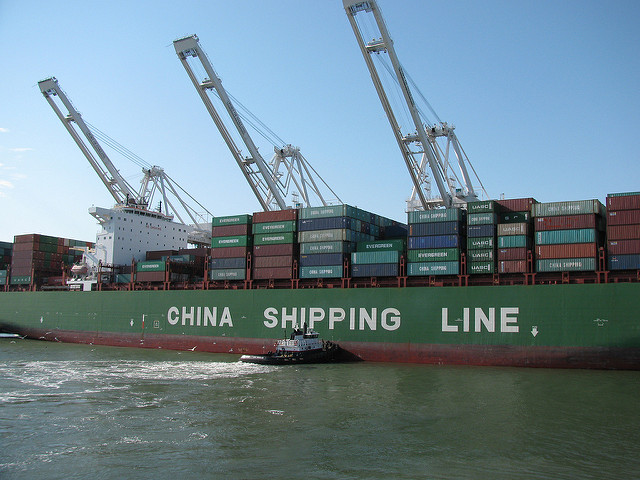
Richard McCormack looks at America’s forgotten National Export Initiative.
The post below is an opinion piece written by award-winning journalist Richard McCormack, the founder and publisher of Manufacturing & Technology News. McCormack also served as the editor of the 2013 book on revitalizing manufacturing, ReMaking America. You can follow him on Twitter at @RichardAMc.
The U.S. export machine is sputtering and things could soon get worse due to the Federal Reserve's decision on Dec. 14 to raise interest rates. The value of the U.S. dollar is on the verge of reaching a high not experienced since 2002, making U.S exports less competitive globally. Higher interest rates make holding dollars more financially attractive, further boosting its value and depressing exports.
Exports of manufactured goods plunged in 2015 by $116 billion, a decrease of 7.2 percent, and the trend continues through 2016. For the first 10 months of this year, exports of goods have dropped by another $60 billion (or 4.7 percent).
This major downward shift in manufactured goods exports was occurring at exactly the same time as the 2016 presidential election was ramping up.
When taking the Commerce Department's calculation that every $1 billion in exports creates 4,000 jobs, the number of jobs lost in 2015 and 2016 in goods manufacturing due to declining exports was 704,000.
The total "merchandise" trade deficit last year was $737 billion ($2 billion per day, or $2,268 per American for the year). At 4,000 jobs per $1 billion of trade, the trade deficit in goods equated to the loss of 2.948 million manufacturing jobs.
Slow growth overseas, an increasingly strong dollar, continued offshore outsourcing, and a lack of American-made consumer products that can be exported have derailed American export totals.
The Evidence
Only two years ago, economists were predicting that the United States was on the verge of exploding export growth due to the advantage of having low energy prices caused by fracking. But that advantage evaporated as foreign producers also benefited from falling global oil prices. In 2014 oil was commanding $100 per barrel, but dropped to only $40 in 2015.
The heavy industries that were expected to benefit the most from low U.S. energy prices are experiencing big decreases in exports. In minerals and metals, U.S. exports fell from $160.5 billion in 2013 to $135.7 billion in 2015, a decline of $25 billion or 15 percent. Meanwhile, imports have stayed steady at $190 billion.
Exports of chemicals declined by $4 billion in 2015 (to $228 billion), but imports are surging, increasing 10 percent, from $237 billion in 2013 to $260 billion in 2015.
Other American manufacturing industries are being hammered by big increases in imports and declining exports. The perception that the U.S. automobile industry is thriving is considerably off base. Imports of transportation equipment are surging at an unprecedented rate, increasing by $50 billion between 2013 and 2015 – a 13 percent jump. Since 2011, imports of transportation equipment have increased by an astounding $113 billion.
U.S. auto producers, meanwhile, exported 2,007,830 passenger vehicles and light trucks last year valued at $54 billion, a decline of $3 billion from the previous year. While imports increased by 700,000 units (from 7,399,742 in 2014 to 8,005,035 in 2015), amounting to $180 billion (up from $167 billion the previous year).
Other important American industrial sectors remain in perilous shape. Exports of American electronics products – an industry largely lost to China – fell from $169 billion in 2014 to $166 billion in 2015, and are stuck at the same level as they were in 2011. We imported $449 billion worth of electronics products in 2015, up from $438 billion in 2014. Since 2011, imports of electronics goods have increased by $47 billion, or 12 percent.
In the all-important sector of "machinery" – the equipment that produces American products – exports plummeted in 2015 to $119 billion, down 6 percent from $127 billion in 2014. Imports increased by $1 billion over the year, and are up by $15 billion since 2013 and by $29.5 billion (19 percent) since 2011 to $185 billion.
The same story held in other sectors as well: In textiles and apparel, in footwear, in forest products.
Even the American agricultural sector is growing less globally competitive. Exports plummeted last year by $18 billion, or 11 percent, from $159 billion to $141 billion. Imports increased by $650 million to $137 billion. Exports of U.S. dairy products fell by an astounding 27.6 percent (to $4.9 billion); while exports of poultry fell by almost the same amount – 27.5 percent.
This export story is not what had been predicted in 2010, when President Obama announced the "National Export Initiative" in his State of the Union address calling for a doubling of exports from 2010 to 2015, an increase that "will support two million jobs in America," he said.
At the time, Obama did not mention that the base from which he was measuring progress was 2009, the year after the financial system collapsed when exports of goods and services had plunged by $260 billion to $1,583 billion. His goal from that year was $3,200 billion by 2015.
How did he do?
The last time the National Export Initiative at the International Trade Commission issued an update was in 2013, when exports of goods and services during the previous year had reached a record $2,218 billion. In 2015, that number had increased to $2,261 billion — approximately $1 trillion short of Obama's goal.
From 2012 to 2015, all of the growth in exports has been in services, increasing by $95 billion. Manufacturing exports have fallen by $53 billion during the same time. Goods exports are on pace to fall by another $70 billion in 2016.
This massive and unreported decline in American goods exports occurred at the same time that Donald Trump took to the campaign trail and proclaimed that the United States was being overwhelmed by foreign trade, a trend that was being felt viscerally and in real time by millions of Americans.
